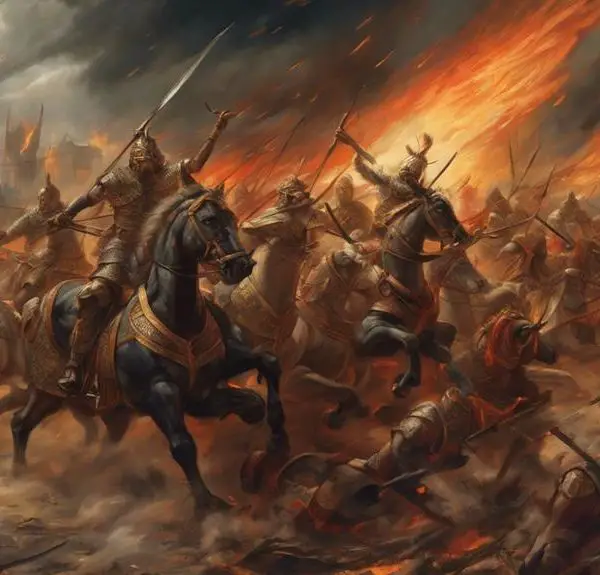The flaming sword in the Bible guards Eden's gates, symbolizing divine protection and mysteries that beckon deeper exploration.

Flaming Swords in the Bible
In the rich tapestry of biblical narratives, the image of a flaming sword gently veils its profound significance, standing as a guardian at the gates of Eden.
You might find yourself intrigued by this vivid symbol, which not only serves as a protective divine instrument but also carries deep symbolic meanings that have evolved over centuries. Its appearance in Genesis sets the stage, yet the layers of interpretation surrounding it invite a deeper exploration.
Why, you may ask, does this fiery weapon captivate scholars and believers alike? The answer lies in the intersection of ancient texts and modern interpretations, a junction that promises to unravel mysteries yet concealed.
Key Takeaways
- The flaming sword symbolizes divine judgment, mercy, and the moral struggle between good and evil.
- It serves as a protective divine instrument, guarding the Tree of Life from unworthy access.
- Represents God's ultimate authority and the purifying force of divine judgment in prophetic visions.
- Evolves in symbolism to reflect societal shifts, embodying themes of purification, enlightenment, and the battle against evil.
The Genesis Account

In the Genesis account, a flaming sword vividly marks the eastern entrance to the Garden of Eden, signifying a divine barrier to humanity's return after their fall from grace. This element isn't merely a dramatic detail; it's a critical component in the narrative that underscores the severity of Adam and Eve's garden expulsion. Following their disobedience, the introduction of the Cherubim, alongside the flaming sword, serves a dual purpose. Firstly, it acts as a physical manifestation of the divine decree, preventing any attempt to access the Tree of Life. Secondly, it symbolizes a spiritual and moral boundary that humanity can no longer cross due to their newfound knowledge of good and evil.
This account is meticulous in its details, emphasizing the consequences of human actions and the irreversible nature of their effects. The Cherubim's presence, coupled with the flaming sword, underscores the gravity of the transgression and the subsequent estrangement from divine favor. This narrative element is pivotal, as it lays the groundwork for themes of exile, redemption, and the complex relationship between humanity and the divine that permeate the biblical text.
Symbolism and Meaning

Exploring the symbolism and meaning behind the flaming sword reveals deeper layers of theological significance in the biblical narrative. This imagery isn't merely about divine retribution or exclusion; it serves multiple, profound purposes within both religious texts and broader cultural contexts. Let's delve into three key aspects:
- Divine Judgment and Mercy: The flaming sword symbolizes God's dual nature of judgment and mercy. It guards the way to the Tree of Life, signifying both a punishment for humanity's disobedience and a protective measure to prevent eternal separation from God due to sin.
- Humanity's Moral Struggle: It represents the ongoing struggle between good and evil within the human heart. The fiery blade illuminates the choices before us, urging moral reflection and spiritual growth.
- Artistic and Cultural Resonance: Artistic depictions of the flaming sword have permeated various cultures, influencing literature, art, and theology. These renditions often highlight the sword's dual nature, serving as a reminder of divine presence and human responsibility across ages.
The flaming sword's rich symbolism and cultural influence underscore its lasting relevance in theological discourse and artistic expression, offering insight into the complexities of divine-human interaction.
Protective Divine Instrument

While often interpreted as a symbol of divine wrath, the flaming sword primarily serves as a protective divine instrument, safeguarding the sanctity of the Tree of Life from unworthy access. This role highlights its significance not just as a weapon but as a guardian entity within the biblical narrative. Its cultural origins can be traced back to ancient Near Eastern mythology, where weapons imbued with divine power often denoted the gods' intervention in human affairs, primarily to maintain cosmic order or protect sacred spaces.
Artistic depictions of the flaming sword have varied significantly across cultures and eras, reflecting its adaptation to the visual language of different periods. In medieval Christian art, it's often represented with elaborate designs that emphasize its divine nature and the intensity of its power. These depictions serve not only as religious symbols but also as artistic expressions of the divine mandate to protect and sanctify.
The flaming sword's portrayal as a protective divine instrument underscores a complex theological concept: divine justice isn't merely punitive but fundamentally oriented towards the preservation of holiness and the prevention of sin. This nuanced understanding challenges simplistic interpretations, inviting deeper reflection on the symbol's multifaceted significance.
Representation in Prophetic Visions

As we delve into prophetic visions, it's evident that the flaming sword's representation transcends its physical embodiment, symbolizing divine intervention and judgment amidst apocalyptic imagery. This potent symbol is woven into the fabric of visionary metaphors, serving as a beacon of divine will and the forthcoming judgment within the tapestry of biblical narratives.
To understand its significance, consider the following:
- Divine Authority: The flaming sword often signifies God's ultimate authority over creation, serving as a reminder of His power to both protect and punish. Its fiery blade pierces through the veil of earthly existence, illuminating the path towards spiritual truth and divine reckoning.
- Purification and Judgment: In the context of apocalyptic imagery, the flaming sword represents the purifying force of divine judgment. It separates the righteous from the wicked, symbolizing the purification process that precedes entry into the divine realm. This metaphor underscores the inevitability of divine judgment and the importance of spiritual preparedness.
- Transition and Transformation: The appearance of a flaming sword in prophetic visions often heralds a period of significant transition and transformation. It marks the end of an era and the beginning of a new divine order, emphasizing the cyclical nature of divine intervention in human affairs.
Through these manifestations, the flaming sword serves as a powerful symbol within prophetic visions, encapsulating themes of divine authority, purification, judgment, and transformative change.
Modern Interpretations

In contemporary discussions, one finds that the symbolism of the flaming sword has evolved, reflecting broader societal and theological shifts in understanding divine judgment and authority. You'll notice that the cultural impact of this imagery isn't static; it's deeply intertwined with changing norms and values. As societies grapple with concepts of justice and protection, the flaming sword's representation in art and literature adapts, serving as a metaphor for divine intervention or moral rectitude in a tumultuous world.
Artistic depictions of the flaming sword have also undergone significant transformations. Initially symbolizing divine wrath and the unapproachable nature of God, modern interpretations often imbue the image with themes of purification, enlightenment, and the struggle against evil. This shift mirrors a broader trend in theological discourse, emphasizing a God who empowers and purifies rather than solely punishes.
Moreover, the flaming sword's resonance in contemporary art highlights its enduring appeal and versatility as a symbol. It's a testament to the power of biblical imagery to transcend its original context, inspiring new generations to explore complex themes of morality, justice, and spiritual warfare through a familiar yet endlessly fascinating lens.
Frequently Asked Questions
How Have Different Cultures Outside of the Biblical Context Interpreted or Depicted Flaming Swords in Their Myths or Artworks?
You've noticed that cultures around the globe have fascinatingly interpreted or depicted flaming swords in their myths and artworks, reflecting deep sword symbolism and cultural exchange.
These fiery blades often symbolize purification, power, or protection, transcending mere physical boundaries to embody metaphysical or spiritual ideals.
This cross-cultural fascination highlights a shared human interest in the mystical, showing how societies adapt and infuse such powerful symbols into their own narratives and artistic expressions.
Are There Any Recorded Historical Artifacts, Such as Sculptures or Paintings, From Ancient Civilizations That Directly Reference the Concept of a Flaming Sword as Described in the Bible?
You're diving into whether any historical artifacts, like sculptures or paintings, depict a flaming sword. It's crucial to scrutinize the artifact's authenticity and preservation techniques to ensure they accurately represent ancient beliefs.
Many cultures have their own interpretations, but finding a direct link to the biblical symbol in artifacts requires a detailed, scholarly analysis. Look for signs of cultural exchange or adaptation in these depictions to understand their origins and significance better.
Has the Concept of the Flaming Sword Influenced Any Modern Technological Advancements or Inspired Any Inventions?
You might wonder if mythological symbolism, like the flaming sword, has spurred any real-world sword technology or inventions. Analyzing this concept reveals that while direct technological advances specifically modeled on this imagery are scarce, the idea has certainly influenced modern design and concept arts, especially in entertainment and fantasy genres.
It's a testament to how ancient symbols can inspire innovation, even if not directly leading to new technological breakthroughs.
Can the Presence of Flaming Swords in the Bible Be Linked to Specific Astronomical or Natural Phenomena That Ancient Peoples Might Have Witnessed?
You might wonder if ancient celestial events or volcanic imagery influenced certain mythical concepts.
It's plausible that such natural phenomena, observed by ancient peoples, inspired the mythos surrounding powerful symbols.
By examining historical records and astronomical data, you can trace parallels between these natural occurrences and the symbolism found in myths.
This analytical approach can reveal how early humans interpreted and immortalized their experiences with nature's awe-inspiring spectacles in their storytelling.
How Have Flaming Swords Been Represented in Contemporary Media, Such as Movies, Video Games, and Literature, and How Do These Portrayals Differ From the Biblical Description?
In contemporary media, you'll find flaming swords depicted with a stunning array of special effects, showcasing their evolution. Movies, video games, and literature employ these fiery blades not just for their visual impact, but for deep narrative symbolism.
Unlike the biblical portrayal, which is steeped in spiritual and divine context, modern interpretations often lean towards fantasy and power themes, highlighting a shift from sacred origins to entertainment and artistic expression.
Conclusion
In conclusion, you've explored the multifaceted role of flaming swords in the Bible, from their initial appearance in Genesis to their symbolic and protective significance. These fiery blades serve not just as divine instruments of protection but also as profound symbols within prophetic visions, embodying themes of divine authority and judgment.
Modern interpretations further enrich our understanding, revealing the depth of their metaphorical significance across religious and scholarly discussions. Thus, the study of these flaming swords illuminates broader themes of divine interaction and protection in biblical literature.



Sign up